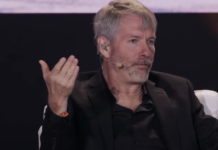Recently announced Ethereum layer-2 scaling network Blast, led by the founder of top NFT marketplace Blur, has pulled in over half a billion dollars worth of locked funds from users seeking yield and rewards—but also faced substantial criticism over its rollout. And now early investor Paradigm has joined the list of parties with issues over the launch.
On Sunday, Paradigm Head of Research and General Partner Dan Robinson shared a post on X (aka Twitter) that took Blast’s launch to task, attributing his comments to “we at Paradigm,” suggesting it conveyed the prominent crypto-centric venture capital firm’s stance.
“There are a lot of components of Blast that I’m excited about and would be interested in engaging with people on,” Robinson wrote. “That said, we at Paradigm think the announcement this week crossed lines in both messaging and execution.”
“For example, we don’t agree with the decision to launch the bridge before the L2, or not to allow withdrawals for three months, since we think it sets a bad precedent for other projects,” he continued. “We also think much of the marketing cheapens the work of a serious team.”
Blast is billed as an Ethereum layer-2 network that offers “native yield for Ethereum and stablecoins,” letting users stake (or lock up) their funds in the network to earn an interest-like return.
The network also promises Blur-like “rewards” ahead for users, enticing early adopters to lock up their funds ahead of a potential airdrop ahead. Blur has already awarded hundreds of millions of dollars worth of its BLUR token to NFT traders, catapulting the marketplace ahead of former leader OpenSea in the process, and that historical example may be enticing for crypto users.
However, while users have been excitedly locking up their funds ahead of Blast’s network launch in 2024—bringing Blast’s total value locked (TVL) to about $535 million at present, per data from DeFi Llama—the team has also faced significant criticism in the process.
Essentially, early users are locking their funds into a bridge that will eventually connect from Ethereum to Blast—but the Blast network isn’t actually live yet. And those funds cannot be withdrawn until the expected mainnet rollout in February, drawing security concerns due to the industry’s history of network bridges being exploited for vast sums of crypto. Some traders and industry builders have also called Blast a Ponzi scheme, given its rewards and referral model.
Blast and Blur co-founder Tieshun “Pacman” Roquerre has rebuked such complaints, writing in a Twitter thread on Friday that there were “a number of misunderstandings” around Blast and attempting to address them.
He also said Friday that Paradigm—which was one of the investors in Blast’s $20 million seed round—had no role in Blast’s rollout plans. In fact, Pacman revealed then that Paradigm asked the Blast team to “make changes” to the launch and that Blast was considering them, but that it would ultimately make any decisions in-house.
Robinson on Sunday praised Pacman and his team for the launch of Blur, which disrupted the NFT market and provided substantial rewards to users in the process. However, Robinson ultimately said that Paradigm and Blast weren’t aligned on certain elements of the rollout, and he felt a need on Paradigm’s behalf to try and advocate for “best practices” in the industry.
“We’ve been discussing our concerns with the team and appreciate their willingness to engage with us, but there are still many points of disagreement,” Robinson wrote. “We invest in strong, independent founders who we don’t always agree with. But we understand that people may look to us to set an example on best practices in crypto.”
“We don’t endorse these kinds of tactics and take our responsibility in the ecosystem seriously,” Robinson concluded.
Decrypt reached out to both Paradigm and Blast for comment, but did not immediately hear back from either side.
Stay on top of crypto news, get daily updates in your inbox.









